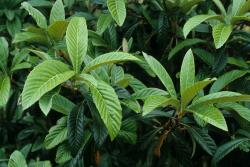- Taxon
- Weed
- Gallery
Tree up to 8 m high when mature; trunk well developed; primary stems erect; secondary stems spreading; young stems stout, white-tomentose; older stems with prominent lf scars, becoming greyish brown and transversely calloused. Lvs near branch tips; petiole c. 15 mm long, stout; blade oblanceolate to narrowly elliptic, 150–350–(400) × 75–100–(130) mm, acute, tapering to cuneate or slightly auriculate base, very coriaceous, ± rugose, dark green and glossy above, thinly grey- or brown-tomentose below (very young lvs completely brown-tomentose), serrate at least in upper 1/2 (sometimes obscurely); stipules long-triangular, ± attenuate, pilose. Infl. of many fls; pedicels 5–8 mm long, brownish tomentose. Sepals fused for most of length; lobes 2–4 mm long, brown-tomentose. Petals white or ivory, oblong, c. 7–8 × 3–4 mm, shallowly emarginate. Fr. pyriform to broadly ellipsoid-oblong or subglobose, up to 50 × 35 mm; skin yellow, ± tomentose; flesh sweet.
[From: Webb et al. (1988) Flora of New Zealand. Volume 4. as Eriobotrya japonica (Thunb.) Lindl.]
Flowering: Apr.–Aug.–(Nov.); Fruiting: Oct.–Dec.




